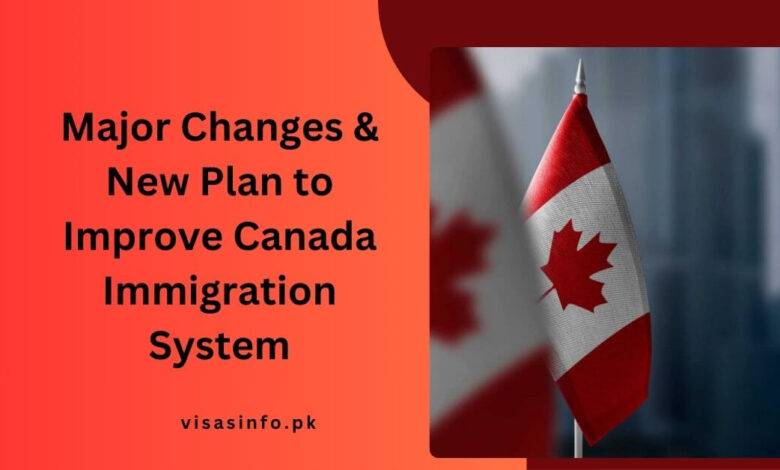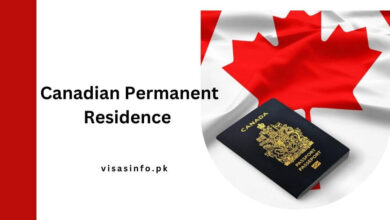Major Changes & New Plan to Improve Canada Immigration System

In this article, we will discuss the substantial modifications that the Canadian immigration department is currently implementing. Currently, Canada is undergoing substantial reforms in its immigration division, despite its reputation for being open to immigrants. These modifications are anticipated to have a significant impact on the future immigration regulations and procedures of the nation, which will affect both Canadian society and foreign nationals.
Immigration, Refugees and Citizenship Canada (IRCC) implemented substantial modifications last week as part of a new strategy to optimize operations. Neil Yates, a former deputy minister for the IRCC, conducted an earlier investigation into the department’s potential for enhancement. The Yates study was requested by IRCC to evaluate the Department’s ability to fulfill its purpose in light of its current organizational structure.
The senior civil servant employed by a government department in a non-political capacity is known as the deputy minister. They are responsible for the administration of their Department, which encompasses the implementation of strategy and plans, as well as personnel and financial management. Christian Fox, the current deputy minister of the IRCC, maintains correspondence with the department’s politician minister, who concurrently functions as immigration minister.
Check Also: DHS Announces 89 Countries Eligible for H-2A and H-2B
Yates Immigration Report
Mark Miller, the minister of immigration, is accountable for the execution of the elected government’s mandate. Yates The IRCC’s organizational structure is defective, according to his assessment, which CIC News was able to obtain. Yates asserts that the staff’s diligence and commitment are the reason the IRCC’s current organizational structure is maintained, despite its flaws.
He proposes a number of measures that must be implemented to realign the organizational structure, such as a substantial transition to a business line-based structure, reform of the governance system, implementation of more robust management systems, particularly planning and reporting, and the promotion of a culture that is more conducive to the Department’s objectives and goals. This includes the consideration of a comprehensive review of the Immigration and Refugee Protection Act and actions to more effectively leverage it.
The IRC C’s current model is flawed for a variety of reasons, but Yates concentrates on two in particular:
- Initially, a challenging operating environment that is both domestic and international in nature
- Secondly, IRCC has experienced a substantial expansion since the implementation of its present organizational structure over two decades ago.
Yates underscores this point by stating that the IRCC’s workforce has grown from 5,352 employees in March 2013 to 12,949 employees as of January 2023.
Fox’s Emotions Regarding His New Role
Fox asserted that the IRCC was comparable to a crisis. Fox stated in a recent interview with journalist Paul Wells that the Yates report would significantly influence the department’s plans to implement substantial changes when she assumed her role at the IRCC in July 2022. Fox informed Wells that her colleagues in the department were experiencing fatigue and pressure in their new roles, which appeared to be a crisis.
She arrived at the realization that departmental modifications were necessary, and although she was hesitant to implement them immediately, she also did not wish to postpone them. Fox had a plan of action in 2024, two years after receiving the Yates report and consulting with public stakeholders, including IRCC applicants.
Ever since she has implemented the reforms gradually. An organization line model was altered by IRCC. In addition to other modifications, the department was reorganized into the following sectors last week.
- Asylum and refugee resettlement
- Citizenship and passport
- Chief Financial Officer
- Economic family and social migration
- Chief Information officer
- Client service Innovation and chief digital officer
- Service delivery
- Communications
- Corporate Services
- International Affairs and Crisis Response
- Migration integrity
- Settlement integration and francophone Affairs
- Strategic policy
Additional Details
Fox notes that the department is now set up across lines of business as Yates had suggested. This means that personnel of the IRCC will be split up among the several clients that the Department Services serves as well as separated in a fashion that will enable them to respond quickly to developments across the world.
For instance, the department recently established a new international affairs and crisis response sector, which Fox explained to Wells is intended to assist IRCC in better planning for humanitarian crises and developing a plan of action IRCC regularly deals with, such as with Ukraine since last year and recent initiatives for the resettlement of Afghan and Syrian refugees, among others.
Further Immigration Plans
Additionally, FOX emphasizes the significance of IRCC taking on more clients. Future efforts should center on having the agency give its conclusions greater weight when considering the applicant’s experiences.
IRCC’s Operating Environment
Yates goes into detail on the numerous factors affecting IRCC. The principal ones are
1. Workplace Hybridization and COVID-19
As a result of the pandemic, it appears that the nature of work is changing forever. As a result, more people, including IRCC staff, are working remotely with a general directive to return to the office two to three days per week, argues Yates. Although working from home has been successful, its effects on IRCC’s organizational culture remain to be seen.
2. Demand for IRCC services
The Department sets targets for itself to process applications for each line of business since the demand for IRCC’s programs frequently exceeds the Department’s processing capacity as determined by its service standards. IRCC has methods and resources at its disposal to manage its inventory, such as caps for some programs, but when demand for its programs exceeds its processing capability, stocks can expand extremely quickly.
3. Growth of IRCC
Both the program’s Workforce and demand for it have increased over time. With 5,217 non-executive employees as of 2013, Yates describes its workforce as medium-sized. By 2023, that number will have more than doubled to 12,721 staff executives. The organizational structure at IRCC, which was created for a smaller department, has essentially remained the same despite the program and staff development.
4. Review of immigration policy
Both the prevalent immigration narrative and the real effects of immigration have not often been well-documented in Canada. A review of IRCC’s immigration policies could help determine the Department’s future course.
5. Digital transformation
For the modernization of its digital platform, IRCC has received sizable funds. Such changes are never easy, especially at an institution like the IRCC where there are numerous important response duties. But there is little question that IRCC must transition to a digital Department.
6. Worldwide uncertainty
Armed conflicts around the world are increasing. Democracy is in danger, and issues like climate change are having an impact on the desire for migration worldwide, which will continue to have a big impact on IRCC. The metal culture at IRCC is dedicated. Yates notes that IRCC currently has inadequate department-wide planning, lacks a multi-year strategic plan, and planning throughout the department is inconsistent while emphasizing the report’s non-critical intent.
All of these provide several difficulties, including the failure to meet the objectives of the Department and a lack of staff responsibility. Inadequacies in the Department’s organizational structure, governance, and management system have been overcome thanks in part to the department’s devoted, collaborative, and supportive culture, according to IRCC workers.
Yates also drew attention to the division that exists within the division between what he refers to as the ERPA school and the customer service school. He points out that a framework to bar applicants was included when the Immigration and Refugee Protection Act was adopted in 2001. Officers are trained to enforce SERPA, which lists numerous reasons why an applicant may have their immigration request denied.
However, the possibility that these police may have unconscious bias that could affect their decision-making has previously received little attention. The people who belong to the client service school are on the other side and are more amenable to compromising and waiving regulations to enhance the service that IRCC clients receive.
Highlights of Yates’s Recommendations
Yates offers advice across four categories, including organizational structure, governance, Systems of management, and cultural highlights. The following are the suggestions
Recommendations for the organizational structure
- IRCC switched to a business line structure
- Also, IRCC creates emergency management protocols that designate assistant deputy minister heads in various
Scenarios, governance, and advice
- The functions of the corporate finance committee are absorbed by the executive committee, which takes over responsibility for finances and corporate services.
- Also, the duties of the issues management committee will be transferred to a new operations committee, which will be led by the deputy Minister’s office.
- Besides that, the membership of these committees be reduced to no more than 12 members and the membership be reviewed as part of the restructuring process.
- Aside from that, to rationalize and streamline roles and accountabilities, a review of the division of duties between IRCC and the Canada Border Services Agency (CBSA) under ARUPA should be carried out.
System recommendations for management
- Deputy Minister departs to establish new planning and reporting procedures
- Also, a three to five-year strategic strategy should be created.
- Additionally, implement a yearly planning cycle for the department’s program, budgetary, HR, and IT goals.
- Besides that, establish a quarterly reporting schedule and make sure it is connected to the department’s performance management.
Work culture recommendations
- Foremost, assess Ripa to see whether changes need to be made to better support the targeted results, such as an improved Service delivery check to see if the department’s desired philosophies and methods are reflected in the training given to staff members working in ERPA administration.
- Also, investigate ways to include the voices of the diverse communities within the IRCC in the departmental governance structure.
It’s an important time for people who want to move to Canada as the country starts these radical reforms in its immigration division.
Benefits of New Plan to Improve Canada Immigration System
- Speedier Processing Times: The strategy includes measures to expedite the processing of a variety of immigration applications and reduce backlogs. This will expedite the reunification of families and individuals and facilitate the entry of foreign students and laborers into Canada.
- Enhanced Technology Integration: Canada is utilizing advanced digital tools and artificial intelligence to modernize its immigration system. This will enhance the system’s transparency and user-friendliness by streamlining the application process, reducing documentation, and providing applicants with real-time updates.
- Targeted Skill-based Immigration: The objective of the plan is to establish pathways that prioritize in-demand skills and sectors in order to more closely align immigration with the requirements of the Canadian labor market. This will primarily benefit critical industries such as healthcare, IT, and skilled trades, as it will address workforce shortages and contribute to economic growth.
- Improved Family Reunification: The enhancements will encompass more accessible family sponsorship programs, which will facilitate the reunification of families in a more efficient manner. This is particularly crucial for the spouses, children, and parents of Canadian citizens and permanent residents.
- Greater Regional Flexibility: The objective of the plan is to enhance regional immigration programs, including the Provincial Nominee Program (PNP) and the Atlantic Immigration Program (AIP), in order to attract skilled immigrants to smaller communities and regions that require additional workers. This will foster equitable population growth throughout Canada.
- Support for Refugees and Humanitarian Efforts: Canada will maintain its global leadership in providing protection to vulnerable groups and ensuring a more efficient and expedited settlement for those in need by enhancing the refugee intake process and humanitarian support.
- Pathways for International Students and Temporary Workers: The plan includes measures to establish more transparent and accessible pathways for temporary workers and international students to transition to permanent residency, thereby increasing the appeal of Canada as a destination for skilled immigrants.
- Enhanced Transparency: The Canadian government is dedicated to enhancing communication with applicants and enhancing transparency in decision-making. This will contribute to the development of trust and the provision of greater predictability for individuals who are working through the immigration process.
Frequently Asked Questions:
-
What is the new policy for immigration to Canada?
Canada’s new immigration policy for international students, foreign workers, and dia spouses. The Canadian government doesn’t set new conditions for international students, foreign workers, and their spouses to cut down the rate of work permits to 35% in 2024, with a plan to issue 485,000 new study permits.
-
What is the plan for Canadian immigration?
The Immigration Levels Plan 2024-2026 set a target of welcoming 500,000 permanent residents to Canada in 2025 and maintaining this target in 2026. Permanent residents can be admitted through economic immigration, family class sponsorship, refugees and protected persons, and humanitarian lines of business.
-
What is the latest immigration trend in Canada?
Canada’s appeal as an immigration destination has been increasing over the past two decades, with a total of 468,817 people immigrating to the country between July 1, 2022, and June 30, 2023. This figure is an increase from 2000-2001 when approximately 252,527 immigrants came to Canada



